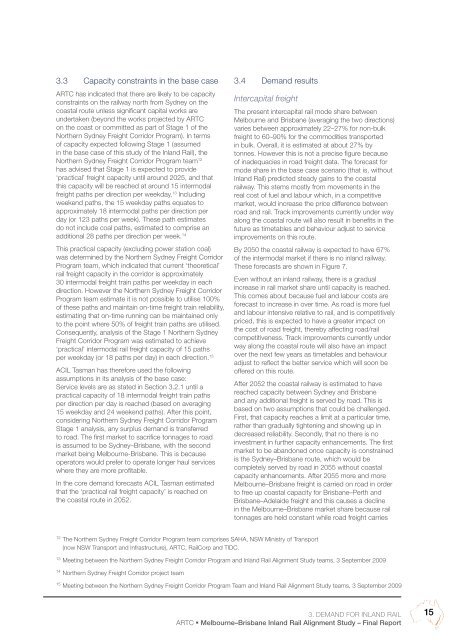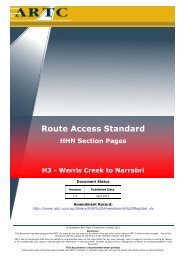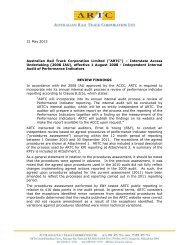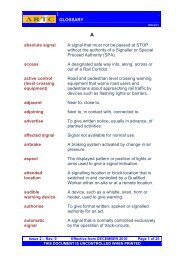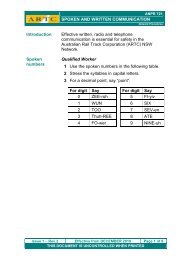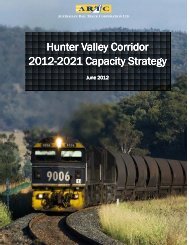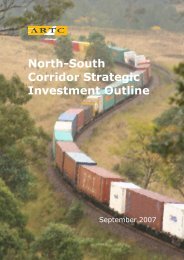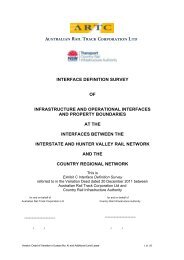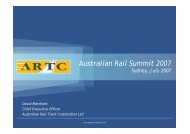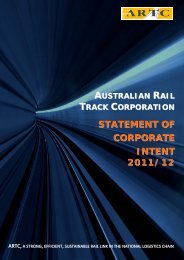MelbourneâBrisbane Inland Rail Alignment Study - Australian Rail ...
MelbourneâBrisbane Inland Rail Alignment Study - Australian Rail ...
MelbourneâBrisbane Inland Rail Alignment Study - Australian Rail ...
You also want an ePaper? Increase the reach of your titles
YUMPU automatically turns print PDFs into web optimized ePapers that Google loves.
3.3 Capacity constraints in the base case<br />
ARTC has indicated that there are likely to be capacity<br />
constraints on the railway north from Sydney on the<br />
coastal route unless significant capital works are<br />
undertaken (beyond the works projected by ARTC<br />
on the coast or committed as part of Stage 1 of the<br />
Northern Sydney Freight Corridor Program). In terms<br />
of capacity expected following Stage 1 (assumed<br />
in the base case of this study of the <strong>Inland</strong> <strong>Rail</strong>), the<br />
Northern Sydney Freight Corridor Program team 12<br />
has advised that Stage 1 is expected to provide<br />
‘practical’ freight capacity until around 2025, and that<br />
this capacity will be reached at around 15 intermodal<br />
freight paths per direction per weekday. 13 Including<br />
weekend paths, the 15 weekday paths equates to<br />
approximately 18 intermodal paths per direction per<br />
day (or 123 paths per week). These path estimates<br />
do not include coal paths, estimated to comprise an<br />
additional 28 paths per direction per week. 14<br />
This practical capacity (excluding power station coal)<br />
was determined by the Northern Sydney Freight Corridor<br />
Program team, which indicated that current ‘theoretical’<br />
rail freight capacity in the corridor is approximately<br />
30 intermodal freight train paths per weekday in each<br />
direction. However the Northern Sydney Freight Corridor<br />
Program team estimate it is not possible to utilise 100%<br />
of these paths and maintain on-time freight train reliability,<br />
estimating that on-time running can be maintained only<br />
to the point where 50% of freight train paths are utilised.<br />
Consequently, analysis of the Stage 1 Northern Sydney<br />
Freight Corridor Program was estimated to achieve<br />
‘practical’ intermodal rail freight capacity of 15 paths<br />
per weekday (or 18 paths per day) in each direction. 15<br />
ACIL Tasman has therefore used the following<br />
assumptions in its analysis of the base case:<br />
Service levels are as stated in Section 3.2.1 until a<br />
practical capacity of 18 intermodal freight train paths<br />
per direction per day is reached (based on averaging<br />
15 weekday and 24 weekend paths). After this point,<br />
considering Northern Sydney Freight Corridor Program<br />
Stage 1 analysis, any surplus demand is transferred<br />
to road. The first market to sacrifice tonnages to road<br />
is assumed to be Sydney–Brisbane, with the second<br />
market being Melbourne-Brisbane. This is because<br />
operators would prefer to operate longer haul services<br />
where they are more profitable.<br />
In the core demand forecasts ACIL Tasman estimated<br />
that the ‘practical rail freight capacity’ is reached on<br />
the coastal route in 2052.<br />
3.4 Demand results<br />
Intercapital freight<br />
The present intercapital rail mode share between<br />
Melbourne and Brisbane (averaging the two directions)<br />
varies between approximately 22–27% for non-bulk<br />
freight to 60–90% for the commodities transported<br />
in bulk. Overall, it is estimated at about 27% by<br />
tonnes. However this is not a precise figure because<br />
of inadequacies in road freight data. The forecast for<br />
mode share in the base case scenario (that is, without<br />
<strong>Inland</strong> <strong>Rail</strong>) predicted steady gains to the coastal<br />
railway. This stems mostly from movements in the<br />
real cost of fuel and labour which, in a competitive<br />
market, would increase the price difference between<br />
road and rail. Track improvements currently under way<br />
along the coastal route will also result in benefits in the<br />
future as timetables and behaviour adjust to service<br />
improvements on this route.<br />
By 2050 the coastal railway is expected to have 67%<br />
of the intermodal market if there is no inland railway.<br />
These forecasts are shown in Figure 7.<br />
Even without an inland railway, there is a gradual<br />
increase in rail market share until capacity is reached.<br />
This comes about because fuel and labour costs are<br />
forecast to increase in over time. As road is more fuel<br />
and labour intensive relative to rail, and is competitively<br />
priced, this is expected to have a greater impact on<br />
the cost of road freight, thereby affecting road/rail<br />
competitiveness. Track improvements currently under<br />
way along the coastal route will also have an impact<br />
over the next few years as timetables and behaviour<br />
adjust to reflect the better service which will soon be<br />
offered on this route.<br />
After 2052 the coastal railway is estimated to have<br />
reached capacity between Sydney and Brisbane<br />
and any additional freight is served by road. This is<br />
based on two assumptions that could be challenged.<br />
First, that capacity reaches a limit at a particular time,<br />
rather than gradually tightening and showing up in<br />
decreased reliability. Secondly, that no there is no<br />
investment in further capacity enhancements. The first<br />
market to be abandoned once capacity is constrained<br />
is the Sydney–Brisbane route, which would be<br />
completely served by road in 2055 without coastal<br />
capacity enhancements. After 2055 more and more<br />
Melbourne–Brisbane freight is carried on road in order<br />
to free up coastal capacity for Brisbane–Perth and<br />
Brisbane–Adelaide freight and this causes a decline<br />
in the Melbourne–Brisbane market share because rail<br />
tonnages are held constant while road freight carries<br />
12<br />
The Northern Sydney Freight Corridor Program team comprises SAHA, NSW Ministry of Transport<br />
(now NSW Transport and Infrastructure), ARTC, <strong>Rail</strong>Corp and TIDC.<br />
13<br />
Meeting between the Northern Sydney Freight Corridor Program and <strong>Inland</strong> <strong>Rail</strong> <strong>Alignment</strong> <strong>Study</strong> teams, 3 September 2009<br />
14<br />
Northern Sydney Freight Corridor project team<br />
15<br />
Meeting between the Northern Sydney Freight Corridor Program Team and <strong>Inland</strong> <strong>Rail</strong> <strong>Alignment</strong> <strong>Study</strong> teams, 3 September 2009<br />
3. Demand for <strong>Inland</strong> <strong>Rail</strong><br />
ARTC • Melbourne–Brisbane <strong>Inland</strong> <strong>Rail</strong> <strong>Alignment</strong> <strong>Study</strong> – Final Report<br />
15


